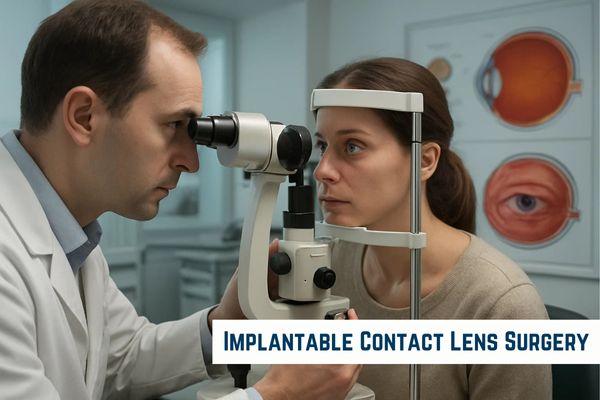Implantable contact lenses (ICLs) have become a popular option for people with refractive vision problems, especially those seeking alternatives to traditional surgery. The procedure offers long-lasting vision correction for patients who may not be candidates due to thin corneas or other issues. However, like any surgical procedure, implantable contact lens surgery does come with risks and understanding the potential post-operative complications is crucial for ensuring a successful outcome.
In this comprehensive review, we will discuss the common and less common post-operative complications in implantable contact lens surgery, the factors that may contribute to these complications, how they can be managed and the preventive measures that can help reduce the likelihood of complications.
What Are Implantable Contact Lenses?
Implantable contact lenses (ICLs) are a type of refractive surgery that involves the implantation of a lens inside the eye to correct vision problems. Unlike traditional contact lenses, which rest on the surface of the eye, ICLs are inserted within the eye, typically behind the iris, to correct near-sightedness, farsightedness or astigmatism.
ICL surgery offers several benefits, including the ability to correct higher levels of refractive error and an overall reduced risk of dryness or discomfort commonly experienced with traditional contact lenses. However, despite its many advantages, post-operative complications can still occur, which is why it is essential for patients to understand potential risks before undergoing the procedure.
Why Do Post-Operative Complications Occur in Implantable Contact Lens Surgery?

Patient-Specific Factors
Surgical Technique
While ICL surgery is generally considered safe, improper surgical techniques or mistakes during the implantation process can lead to complications. This can include errors in positioning the lens, causing it to become misaligned or shifting after surgery.
Intraocular Pressure Changes
Changes in intraocular pressure (IOP) following surgery may increase the risk of complications such as glaucoma or corneal edema. These changes in pressure can cause discomfort and impair healing.
Infection
Pre-existing Eye Conditions
Testimonials
“I have seen Mr. Nanavaty Several Times, and he is always very professional and friendly”
Do Post-Operative Complications Impact Recovery?
Increased Risk of Infection
Increased Intraocular Pressure
Lens Displacement
Corneal Edema
Glare and Halo Effects
Client Speaks
“I would be completely happy to see this doctor again“
When Do Post-Operative Complications Typically Occur?
Most complications in ICL surgery occur during the first few days or weeks following the procedure. The initial recovery phase is critical for monitoring any signs of complications, as early intervention can help mitigate potential issues. However, some complications may not become apparent until several months or even years after surgery.
For example, lens displacement or changes in intraocular pressure may occur after the initial healing period. It is important for patients to continue attending follow-up appointments with their surgeon to ensure that the implant remains in proper position and that there are no signs of complications.
Where Do Post-Operative Complications Occur in Implantable Contact Lens Surgery?
How Are Post-Operative Complications Managed?

Infection Management
Controlling Intraocular Pressure
Lens Realignment or Replacement
Treatment for Corneal Edema
Managing Visual Disturbances
Conclusion
Frequently Asked Questions - Contact Lens Surgery
Q1. What are the common post-operative complications in implantable contact lens surgery?
A. The most common complications include infection, increased intraocular pressure, lens displacement, corneal edema and glare or halo effects.
Q2. How long does it take to recover from implantable contact lens surgery?
A. Recovery time varies by individual, but most patients experience initial healing within a few weeks, with full recovery taking several months. Follow-up appointments are crucial during this time.
Q3. Can complications from implantable contact lens surgery be prevented?
A. While not all complications can be prevented, ensuring proper pre-operative evaluation, following post-operative care instructions and attending follow-up visits can reduce the risk of complications.
Q4. How are post-operative complications treated?
A. Treatment for complications varies depending on the issue but can include antibiotics for infections, medication for intraocular pressure, repositioning of the lens and anti-inflammatory treatments for corneal edema.
Q5. What should I do if I experience vision problems after ICL surgery?
A. If you notice any issues such as blurred vision, glare or discomfort, contact your surgeon immediately. Early detection and treatment can help manage potential complications effectively.
